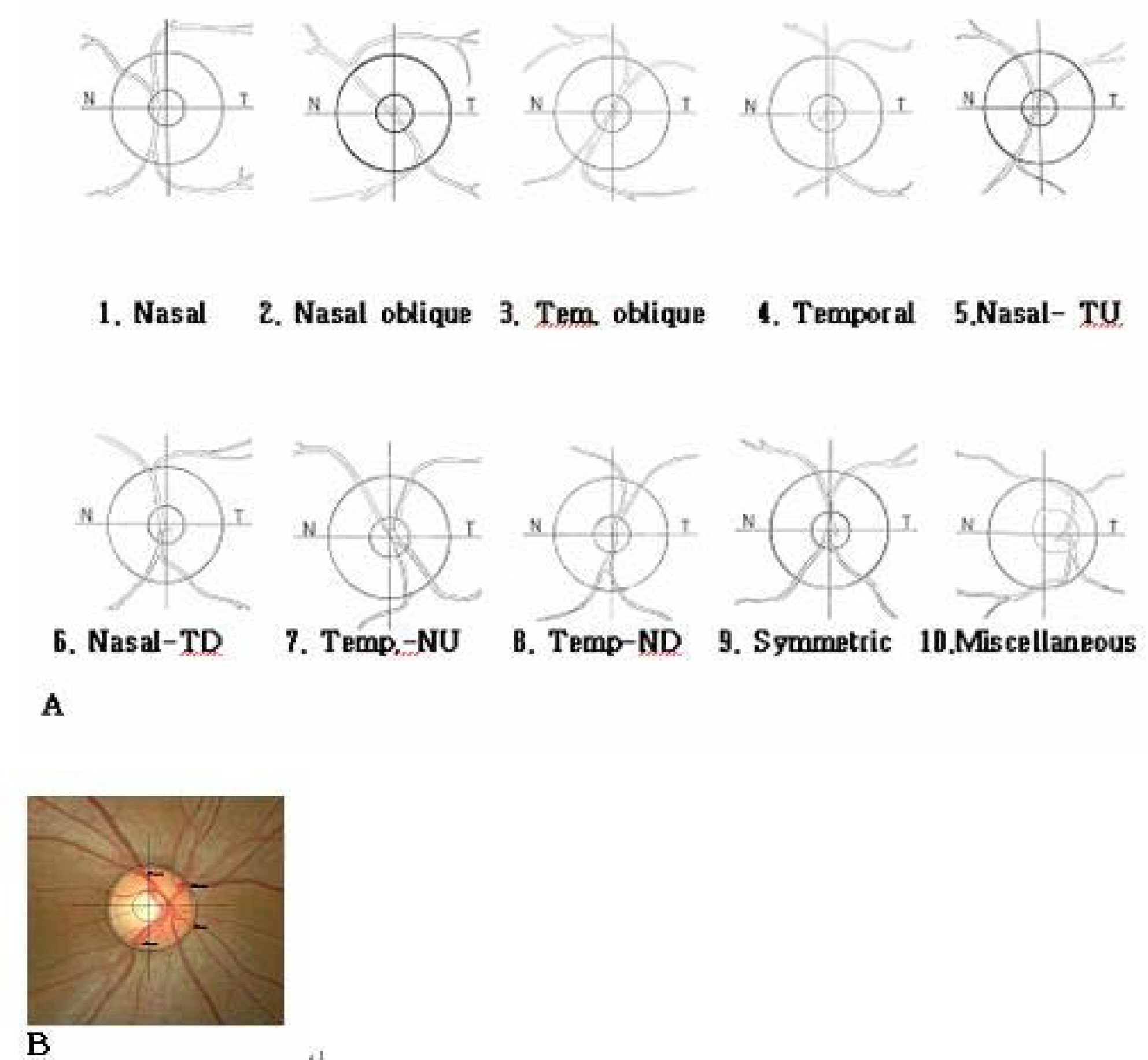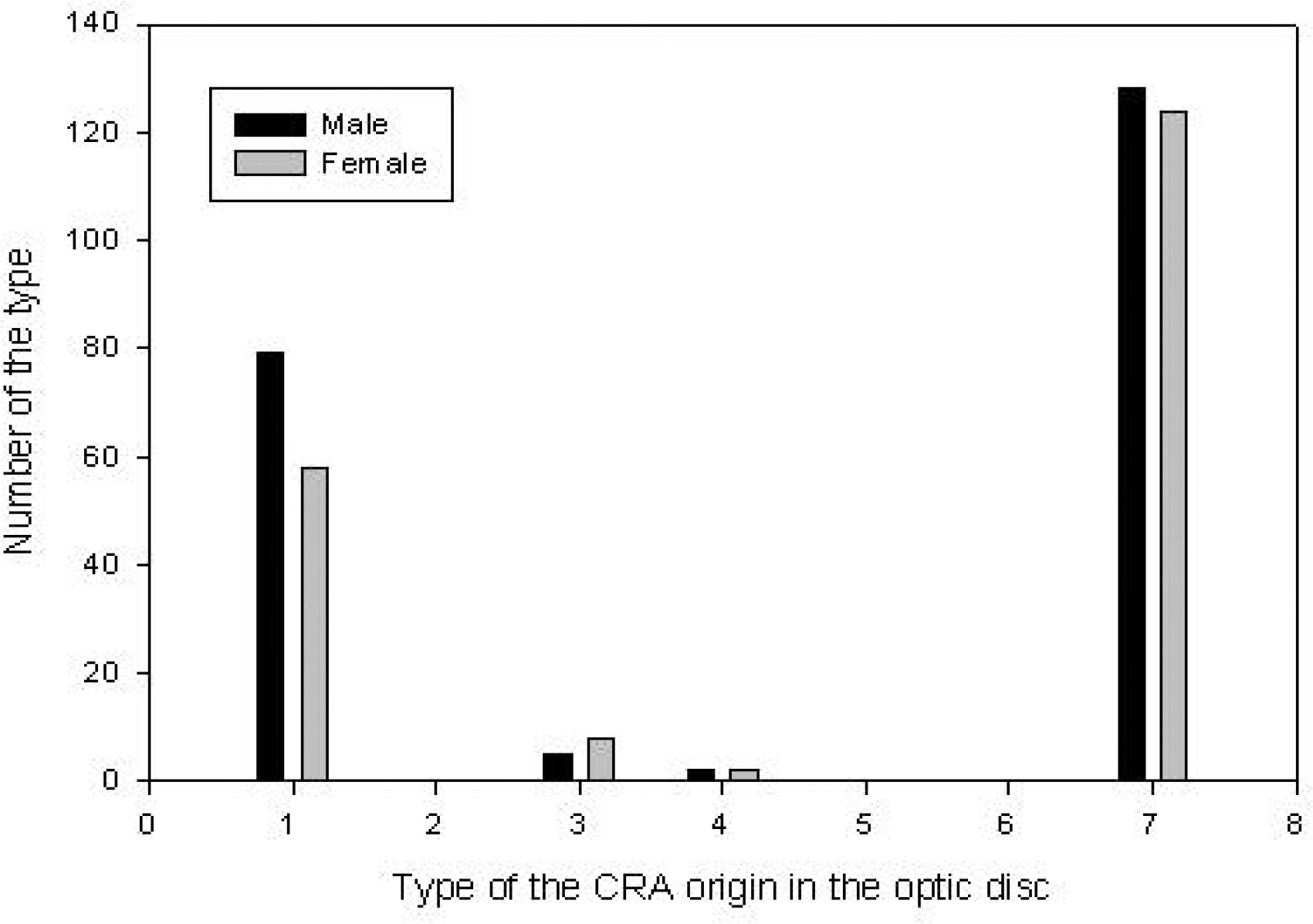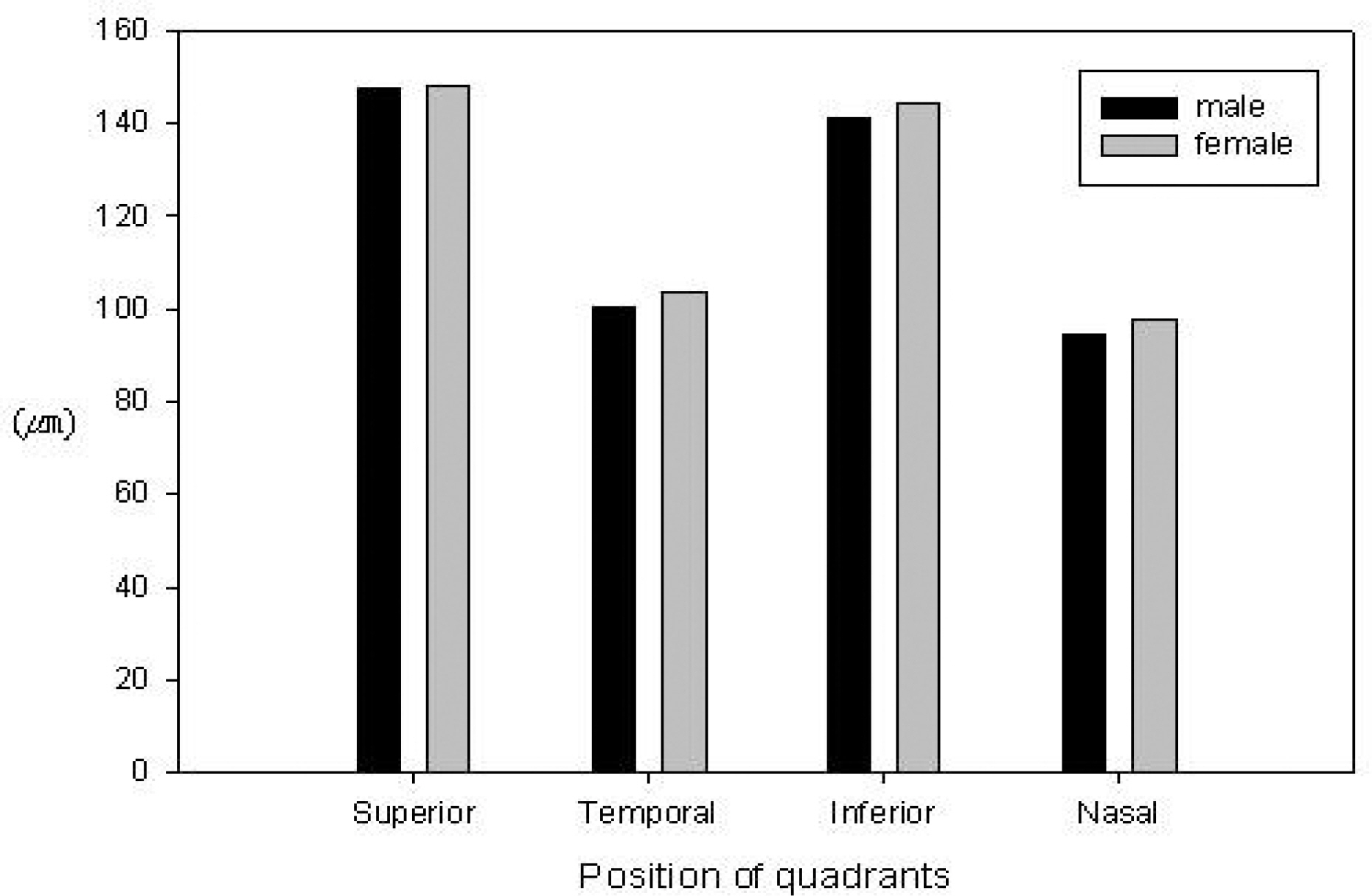J Korean Ophthalmol Soc.
2007 Oct;48(10):1369-1378. 10.3341/jkos.2007.48.10.1369-1378.
Morphological Analysis of Papillary Retinal Vessels and Retinal Nerve Fiber Layer in Koreans
- Affiliations
-
- 1Department of Ophthalmology, College of Medicine, Konkuk University, Seoul, Korea. eyekim@kuh.ac.kr
- 2Department of anatomy and cell biology, College of Medicine, Hanyang University, Seoul, Korea.
- KMID: 2210991
- DOI: http://doi.org/10.3341/jkos.2007.48.10.1369-1378
Abstract
-
PURPOSE: The study present the central retina arterial supply, optic disc shape, RNFL (retinal nerve fiber layers) thickness and optic disc rim area.
METHODS
To evaluate the relationship between central retina artery pattern, optic disk shape, and RNFL thickness was measured using optical coherence tomography (OCT3000) and pattern of the central retinal artery were investigated by TRC50IX. Healthy Koreans (107 males, 97 females) were enrolled in this study. The classification is made by dividing surface of the nerve head into ten sector.
RESULTS
As a result of the shape of the optic disc divided into four group, vertically oval were 54%. The results showed the central retinal artery, in 252 eyes, had its origin in the center. None of the eyes had their origin on temporal side. RNFL thickness according to OCT parameter was superior, 127.68+/-16.16 micrometer; temporal quadrants, 79.60+/-16.05 micrometer; inferior quadrants.
CONCLUSIONS
In summary, this study indicates that in healthy Koreans the shape of the optic disc is vertically oval and the origin of their central retinal artery is at the center. The RFNL thickness of both the superior and inferior quadrants was 127 micrometer according to OCT.
Keyword
MeSH Terms
Figure
Reference
-
References
1. Wood EH. The normal optic nerve. Classification of the optic disc based on branching of the central retinal artery. Arch Ophthalmol. 1948; 39:305–12.2. Ford M, Sarwar M. Features of a clinically normal optic disc. Br J Ophthalmol. 1963; 47:50–8.
Article3. Syndacker D. The normal optic disc, ophthalmoscopic and photographic studies. Am J Ophthalmol. 1964; 58:958–65.4. Kim SD, Choi O, Lee JH. Classification of the optic disc. J Korean Ophthalmol Soc. 1976; 17:177–86.5. Lee SH, Pak BK. On the Ratio to the Physiologic Cupping and Optic Disc. J Korean Ophthalmol Soc. 1971; 12:145–7.6. Kim JW, Yun DH. C/D Ratio of Korean. J Korean Ophthalmol Soc. 1981; 22:181–91.7. Carpel EF, Engstrom PE. The normal cup-disk ratio. Am J Ophthlmol. 1981; 91:588–95.
Article8. Chang HR, Choi O. Relationship Between the Optic Disk and Retinal Vessel. J Korean Ophthalmol Soc. 1982; 23:115–25.9. Quigley Ha, Dunkelberger GR, Green W. Retinal ganglion cell atrophy correlated with automated perimetry in human eyes with glaucoma. Am J Ophthalmol. 1989; 107:453–64.
Article10. Chauhan DS, Marshall J. The interpretation of optical coherence tomography images of the retina. Invest Ophthalmol Vis Sci. 1999; 40:2332–42.11. Schuman JS, Tamar PK, Hertzmark E, et al. Reproducibility of nerve fiber layer thickness measurements using optical coherence tomography. Arch Ophthalmol. 1996; 103:1889–98.
Article12. Poinoosawmy D, Fontana L, Wu JX. Variation of nerve fiber layer thickness measurements with age and ethnicity by scanning laser polarimetry. Br J Ophthalmol. 1997; 81:350–4.13. Park HJ, Choi JH, Choi KY, Hong C. Relationship between Optic Disc Parameters and Myopic Refractive Errors in Myopia. J Korean Ophthalmol Soc. 1999; 40:1084–9.14. Quigley HA, Dunkelberger GR, Green WR. Chronic human glaucoma causing selectively greater loss of larger optic nerve fibers. Ophthalmology. 1998; 95:357–63.15. Kim JM, Park KH, Kim TW, Kim DM. Comparison of the Results between Heidelberg Retina Tomography 2 and Stratus Optical Coherence Tomography in Glaucoma. J Korean Ophthalmol Soc. 2006; 47:556–62.16. Kestenbaum A. Red shadows on the retina. Klin Monatsblatter Augenheilkd Augenarztl Fortbild. 1954; 125:663–6.17. Jeong TM, Lee JH, Kim SD, Choi O. Classification of the Optic Disk based on branching of the central retinal artery. J Korean Ophthalmol Soc. 1975; 16:205–8.18. Jung JH, Kim HW, Kim SD, Choi O. Classification of the Optic Disk Based on Branching of the Central Retinal Artery. J Korean Ophthalmol Soc. 1976; 17:275–9.19. Ogden TE. Nerve fiber layer of the primate retina: Morphometric analysis. Invest Ophthalmol Vis Sci. 1984; 25:19–29.20. Sears ML. Clinical and scientific basis for the management of open-angle glaucoma. Arch Ophthalmol. 1986; 104:191–5.21. Verma R, Bazzaz S, Lai M. Optical tomography-measured retinal nerve fiber layer thickness in normal Latinos. Invest Ophthalmol Vis Sci. 2003; 44:3369–73.22. Lee JH, Ahn JS, Lee DY. Quantification of Retinal Nerve Fiber Layer Thickness in the Normal Subjects Using Optical Coherence Tomography. J Korean Ophthalmol Soc. 1999; 40:2804–15.23. Savini G, Zanini M, Carelli V, et al. Ross-Cisneros FN, Barboni P. Correlation between retinal nerve fiber layer thickness and optic nerve head size: an optical coherence tomography. Br J Ophthalmol. 2005; 89:489–92.24. Schuman JS, Wollstein G, Farra T, et al. Hertzmark E, Ay din A, Fujimoto JG, Paunescu LA. Comparison of optic nerve head measurements obtained by optical coherence tomography and confocal scanning laser ophthalmoscopy. Am J Ophthalmol. 2003; 135:504–12.25. Tuulonen A, Lehtola J, Airaksinen PJ. Nerve fiber layer defects with normal visual fields. Ophthalmology. 1993; 100:587–98.
Article26. Ha SW, Rho SH. Age-Related Differences of Optical Coherence Tomography Data in Korean. J Korean Ophthalmol Soc. 2005; 46:2037–44.27. Medeiros FA, Zangwill LM, Bowd C, et al. Evaluation of retinal nerve fiber layer, Optic nerve head, and macular thickness measurements for glaucoma detection using Optical Coherence Tomography. Am J Ophthalmol. 2005; 139:44–55.
Article28. Kanamori A, Escano MF, Eno A, et al. Evaluation of the effect of the aging on retinal nerve fiber layer thickness measured by optical coherence tomography. Ophthalmologica. 2003; 217:273–8.
- Full Text Links
- Actions
-
Cited
- CITED
-
- Close
- Share
- Similar articles
-
- Reproducibility of Retinal Nerve Fiber Layer Thickness Evaluation by Nerve Fiber Analyzer
- Biometry of Retinal Nerve Fiber Layer Thickness by NFA
- Associations of Peripapillary Retinal Nerve Fiber Layer and Macular Retinal Layer Thickness with Serum Homocysteine Concentration
- Influence of Diabetes Mellitus on the Retinal Ne rve Fiber Layer Thickness Measurement by Nerve Fiber Analyzer
- A Case of Retinal Herniation through Peripapillary Pit Resulting in Retinal Nerve Fiber Layer Defect






